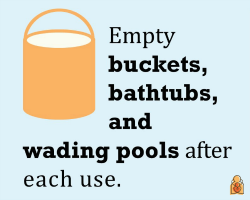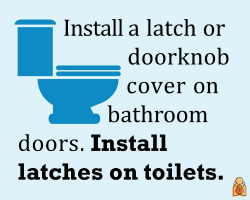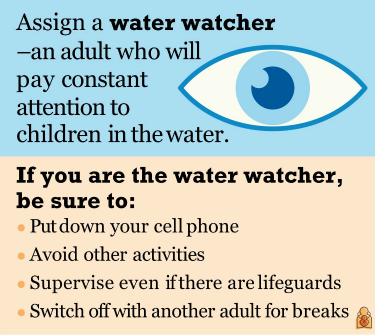Many toddlers―curious, active and eager to explore their surroundings―are attracted to water. It shines, ripples, splashes, and can even make things float! But, they don't understand that water can be dangerous and aren't old enough yet to do what is needed when in trouble. So, it's essential to protect them from water hazards where you live and where you visit.
The toddler years = higher drowning risk than any other time
Water safety is important for all ages, but especially for toddlers. Drowning is the leading cause of injury death in children 1-4. Young children can drown in as little as an inch or two of water, and it can happen quickly and silently.

The biggest drowning threat facing families with toddlers is unexpected, unsupervised access to water: swimming pools, hot tubs and spas, bathtubs, natural bodies of water such as ponds and standing water in homes. For example, 69% of all drownings among children age 4 and younger happen during
non-swim times.
Create layers of protection to keep your toddler safe
To lower the risk of drowning and other water-related injuries to children, the American Academy of Pediatrics (AAP) recommends using
"layers" of protection. When children are not expected to be around the water (non-swim times), barriers can help prevent tragedies during inevitable, brief lapses in supervision which are a normal part of every day. When children are playing in and around water, close and constant supervision become essential.
Check for water dangers at home and where you visit
Preventing unintended, unsupervised access to water is proven to be one of the most effective ways to reduce drowning deaths among young children. Start with these layers of protection in and around your
home to help make your toddler's environment safer.
Fence and secure swimming pools
Research suggests that fencing can prevent
more than half of all swimming pool drownings of young children. Swimming pools, including large, inflatable above-ground pools and other temporary pools, should be completely surrounded by a fence on all 4 sides. The fence should:
be at least 4-feet high and have no opening under it or between slats that are more than 4 inches wide
completely separate the pool from the house
have a self-closing and self-latching gate that opens away from the pool, with the latch at least 54 inches from the ground
Keep the gate locked at all times and check it frequently to be sure it works. Keep toys out of the pool area when not in use so that children are not tempted to try to get through the fence during non-swim time. Also be sure to always cover and lock hot tubs, spas and whirlpools right after using them.
Remove or fence other backyard water hazards
Bird baths, fountains and ponds. Although these can be beautiful landscape features, consider holding off on installing or using them until your child is older.
Wells, irrigation or drainage ditches. Also be careful to prevent children's access to open post holes while structures like fences, decks, birdhouses and flagpoles are being put in.
Prevent your child from going outside unnoticed
Use safety gates, door locks or doorknob covers to prevent your toddler from going outside or into your garage unnoticed. Make sure siblings and all other family members know to always close the door behind them so younger children don't follow them out.
 Empty water containers immediately after use
Empty water containers immediately after use
Never leave a filled, open-top water container unattended. Whenever they're not in use, be sure to completely empty any liquids in containers such as:
buckets and pails used for cleaning or painting
wading pools
coolers with melted ice
large water bowls for pets
trash cans or recycling bins that may collect rainwater
 Block unsupervised access to bathrooms
Block unsupervised access to bathrooms
The bathroom can be a risky place for toddlers. They can topple headfirst into toilet bowls and filled tubs, or scald themselves with water that's too hot. Use safety latches or doorknob covers to keep bathrooms closed when they're not in use. As an added layer of protection, install latches or locks on toilet seat lids, and consider removing the bath tub drain plug when it's not in use to avoid the tub filling if a child turns on the faucet.
Provide close, constant supervision in and around water
Whenever your toddler is in or near water, give them your undivided attention. It's important to avoid doing anything that would make it hard to stay focused, such as using your cell phone, doing yard work or drinking alcohol.
Use touch supervision in or near the water
The AAP recommends staying within arm's length, providing constant "touch supervision," whether it's bath time or swim time. Most child drownings inside the home occur in bathtubs, usually during a lapse in adult supervision. During swim time, get in the water with your toddler. If you need to get out, take your child with you, even if lifeguards are present.

Especially during parties or picnics at the pool or lake, when it's easy to get distracted, assign a "water watcher" to constantly keep eyes on the child. Take turns, passing along a water watcher card to the next responsible adult after a set time (such as 15 minutes).
Use life jackets near lakes and rivers
Children should always wear
life jackets when in, on, or near natural bodies of water, such as lakes or rivers. Make sure they fit properly and are approved by the U.S. Coast Guard. Children and others who lack strong swim skills should also wear life jackets when at a pool or water park.
Start swim lessons as soon as your child is ready
The AAP recommends
swim lessons for all children, and their parents, as another layer of water safety. Recent studies suggest that water survival skills training and swim lessons can help reduce drowning risk for all children including those 1 to 4 years.
Deciding
when to start should be based on a variety of individual factors. These include how often your child may be around water, your child's emotional maturity, physical and developmental abilities and limitations, interest in learning to swim and how comfortable they are in the water. Your pediatrician is a good resource to help know if your toddler is ready. Parent-child swimming lessons
If you never learned to swim, you're not alone—and it's not too late! At least 15% of people in the U.S. say they cannot swim. This includes people from all backgrounds, but culture, race and income do play a role. For example, segregated pools and beaches kept generations of African American adults from getting quality swim lessons.
(See video below.) And
nearly 80% of children from households earning less than $50,000 lack good swimming skills, often because their parents never learned.
Enrolling in
parent-child swim lessons is a great way to spend time with your child. Plus, your child will be safer and more confident near water if you can swim together as a family.
|
Be ready to respond
Know how to respond when there is trouble. Everyone, including parents, caregivers and older children, should
learn CPR and safe rescue techniques to respond to a drowning incident. Water safety is a family affair!
Remember
Always keep your toddler's safety in mind around water―at home, where your friends, relatives, and caregivers live and places you stay during family trips. Prevent unsupervised access during non-swim times and provide close, constant supervision while in or around water. Be sure to talk with your pediatrician at your child's wellness visits about guarding against common water dangers.
More information